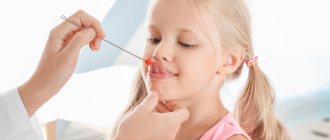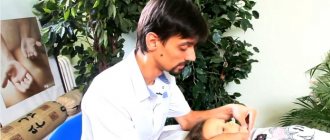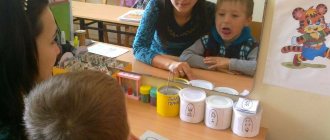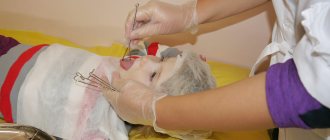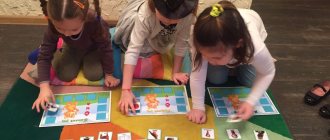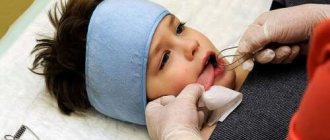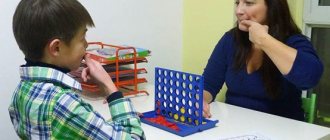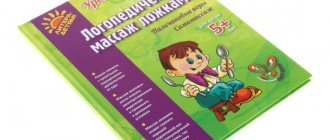December 3, 2021 Speech development defects in children (dysarthria) usually have complex causes. This may be disturbances in the speech centers of the brain, problems with the transmission of nerve impulses, or insufficient mobility of the speech organs. The main method that helps children begin to speak normally is speech therapy massage for dysarthria. It can be compared to training in the gym, because the speech organs - and, above all, the tongue - are controlled by the work of the muscles. With the help of the procedure and regular exercises, you can quickly achieve good pronunciation of all sounds, including the most complex ones.
general information
Like any procedure, facial massage for dysarthria in children has its own indications and rules. First of all, this is the qualification of a specialist. The speech therapist must be trained in this area and have completed training courses.
It is advisable that he constantly study the relevant literature and improve his qualifications.
To perform a massage you need a couch or chair. They should be easy to use. If necessary, take flat pillows (they are placed under the back, which leads to muscle relaxation) and bolsters.
The massage therapist's hands must be clean and free of abrasions, calluses, warts, etc. At the first appointment, the child is diagnosed and muscle tone is determined. They can be too tense (hypertonicity) or too relaxed (hypotonicity).
A speech therapist must understand anatomy, physiology, and psychology. Every action must be thought out. Only with this approach can sessions be conducted.
Who treats dysarthria
To correct the situation, you need to contact two specialists - a neurologist and a speech pathologist. An accurate assessment of the condition can only be determined after a thorough examination and history taking.
Corrective measures are also carried out in two directions - neurological and speech therapy. An integrated approach includes methods such as:
- Drug therapy.
- Physiotherapy.
- Physiotherapy.
- Speech therapy classes.
Indications for speech therapy massage
Not all children with speech problems need a special massage. First of all, it is necessary for those who have problems with muscle tone. It is difficult for a child to pronounce sounds, he has increased salivation or paresis - all this requires a massage.
Rhinolalia occurs with birth defects such as cleft lip, gum and palate. Because of this, sounds are distorted. After surgery, massage helps prevent the appearance of scars.
When stuttering, cramps often occur, which constrict the muscles and prevent them from working fully. Therefore, Dyakova has developed a whole range of interventions that help overcome the problem.
In speech therapy, different voice disorders are distinguished: aphonia (inability to speak loudly, only in a whisper) and dysphonia (hissing, nasal sound, etc.). Paralysis and paresis affect the muscles of the larynx. To get rid of them, special techniques are used.
After a stroke, head injury, or severe infectious diseases, speech breakdown often occurs - aphasia. With it, problems with reproducing small movements are often observed. Therefore, such exposure helps reduce their manifestation.
The peculiarity of speech therapy massage is that it affects only the face. It can be carried out only by hand or using special instruments - probes.
The frequency of sessions and their duration are selected for a specific child. The main types of influence are rubbing, kneading, stroking. They shouldn't cause serious pain.
Correction of dysarthria with massage in children
Speech therapy massage for various forms of dysarthria involves mechanical effects on various parts of the face and on the tongue. As a result, pathological symptoms in the peripheral part of the speech apparatus are eliminated, and muscle tone changes.
As a result, in the child, the strength of muscle spasms and their number decreases, and muscle tone normalizes with dysarthria (articulatory and facial muscles). The mobility of the speech organs is restored, blood flow in the soft tissues of the face and brain improves.
These factors help improve the quality of speech: it becomes smooth, expressive, and understandable to others. The baby begins to behave calmer and sleeps better.
Speech therapy massage is prescribed only by a speech therapist after a detailed examination. The specialist assesses the degree of the violation and, depending on this, selects an individual correction scheme.
Small nuances
Some children's centers present speech therapy massage as a panacea for all speech problems. However, there is no consensus among experts about the use of this method for certain problems.
For example, with delayed speech development, such an effect will not play a key role. The defect is based on impaired development of brain regions. Speech therapy massage will not help fix them. There is no clear opinion among experts about the need for such intervention. Only a relaxing massage may be indicated.
For problems with writing, reading and counting, the procedure is also useless, since the defect is based on other disorders. It is their elimination that needs to be addressed. It is possible to use finger massage to stimulate fine motor skills.
It is important to consider the causes of the defect. If a child does not have enough exhalation to pronounce the sound “R”, then kneading his tongue or cheeks will not help him with this. If you have problems with hearing, intelligence or vision, such influence is also useless.
For cerebral palsy, speech therapy massage is often recommended, but it is not always permitted. Only a neurologist has the right to prescribe such procedures. If done incorrectly, massage can only cause harm.
Important rules of logomassage
Articulation massage for dysarthria is undoubtedly an effective method of correction. To benefit and avoid complications, the following conditions must be met:
- All stages of treatment are controlled by a speech therapist: drug treatment, physiotherapy, massage. Therefore, choosing a specialist is one of the fundamental moments in therapy;
- In addition to professional qualities, it is important to establish emotional contact between the speech therapist and the child. This means that a specialist must be able to find a common language with children of different ages. If the child behaves awkwardly and starts throwing tantrums during sessions, there will be no benefit from such procedures, no matter what credentials the speech therapist has;
- The room in which a relaxing massage for dysarthria is performed should be comfortable. It is necessary to ventilate it, remove distracting objects;
- It is better to do the procedures while lying down. But if the child is so uncomfortable, he can sit down;
- The child should be in a good mood, well-fed and happy. Treatment cannot be carried out when he is tired, emotionally overworked or sick. During the massage he should not experience discomfort or pain;
- Your mood is also important. If you are excited and nervous, the baby will feel it and will also begin to worry;
- If you use a spoon or brush, purchase them specifically for massage;
- The sooner you start therapy, the faster you will get results. Therefore, pay attention to the child’s speech, especially if he is at risk: your pregnancy and childbirth were difficult, you were sick during pregnancy, the child had a traumatic brain injury, he was seriously ill for a long time, you have close relatives with speech problems. disorders. The first “bells” are limited mobility of the lips, palate, tongue, difficulties with sucking and swallowing food. Nasal and slurred speech when the child begins to talk. If you notice these symptoms, consult your doctor;
- The procedures will be effective only with an integrated approach. This means that at the same time lessons are held with a speech therapist on sound production, breathing exercises, and the development of fine motor skills.
Be patient. Lead a normal life: let your baby feel that he is no different from the rest, that he is also loved and appreciated. This is an important point that will undoubtedly help him cope with his problems.
Contraindications
Before each session, the speech therapist checks the child’s condition. He should not have any colds or feel unwell. It is unacceptable to manipulate skin problems (boils, warts, fungus, etc.).
The session should not be performed if you have problems in the oral cavity. Especially with stomatitis and caries, as bacteria will spread throughout the mucous membrane. After surgical interventions, massage should also not be done.
Exception: cutting the hyoid ligament - manipulations are needed immediately, otherwise a scar will appear.
For any serious pathologies, such as cerebral palsy, you need to carefully look at the child’s reaction. This is especially important for diagnosed epilepsy. If a preschooler cries, screams and breaks out, then the session is stopped.
Probe and any other types of massage are carried out in a separate room. If this is not possible, then it is done in the speech therapist's office. The room should be warm, ventilated, without drafts.
Tongue massage for dysarthria is not always pleasant. A competent specialist sees the line between slight discomfort and pain. It should never come to the second.
"Confidence"
annotation
: The article is aimed at improving the knowledge of the special education system about the peculiarities of language and speech development of children with mild dysarthria. The effectiveness of the use of speech therapy massage technologies and dynamic electrical neurostimulation (DENS) significantly reduces the time of correctional intervention. This work experience will be useful for speech therapists involved in the correction of phonetic and general speech disorders.
Keywords
: Features of language and speech development of children, pseudobulbar dysarthria, speech therapy massage, DENS therapy technology.
Recently, one of the pressing problems of obstetrics is birth trauma, combined injuries of the brain and spinal cord. Subsequently, during a speech therapy examination of such children, it is often revealed that they have mild, erased symptoms of damage to the central nervous system, which makes it possible to diagnose mild pseudobulbar dysarthria. It is characterized by the absence of obvious disorders of the general motor sphere and the presence of disorders of articulatory and facial motor skills.
1. Clinical, psychological and pedagogical characteristics of children with mild pseudobulbar dysarthria.
The etiology of pseudobulbar dysarthria is quite controversial. In the anamnesis, as a rule, there is evidence of the presence of adverse external influences during the prenatal, natal and postnatal periods of the child’s development.
Common causes include: toxicosis of pregnancy (in 60% of mothers), chronic hypoxia and fetal dystrophy (in 10% of cases), intrauterine infection of the fetus (in 22% of cases), acute and chronic diseases of the mother during pregnancy (in 32% of mothers) , asphyxia in the natal period (in 10% of children), labor disorders (in 56% of cases), birth trauma of the head, cervical spine (in 24% of children) and other types of pathologies. Their influence leads to the emergence of a number of specific deviations in the development of children (R.A. Belova-David, G.V. Gurevets, S.I. Mayevskaya, E.F. Sobotovich, etc.).
The early postnatal development of such children is characterized by excessive motor restlessness, frequent causeless crying, sleep disturbances, frequent startlings, and chin tremor. These features suggest the presence of lesions of the central nervous system in children already in infancy.
According to parents, babies at an early age experience feeding problems in the form of sluggish sucking, rapid fatigue, and frequent regurgitation, which makes it possible to assume that they have early manifestations of symptoms of pseudobulbar dysarthria in the form of miniparesis of the articulatory muscles of the lips, tongue, lower jaw, and pharynx. In a later period (1-2 years), children experience a delay in the development of independent feeding skills (inability to use a spoon, drink from a mug). Also difficulty chewing and swallowing solid food.
Indicators of psychomotor development in children with symptoms of mild dysarthria are generally within the age norm. During the first years of life (from birth to 3 years), many children are monitored by a pediatric neurologist with various diagnoses. Indicators of early speech development in children range from normal to some delay. The first words are observed in babies at 7-15 months, an elementary phrase at 1.5-3.5 years. At the same time, children’s speech remains poorly intelligible for quite a long time; the phonetic side of speech turns out to be unformed. Features of the neurological status and state of motor functions.
In speech therapy practice, we often encounter children with complex sound pronunciation disorders and long-term dynamics of correctional work, who, in the conclusion of a neurologist, have evidence of the absence of focal microsymptoms. However, with a more thorough neurological examination using functional loads, they often reveal minimal symptoms of organic damage to the central nervous system, which is the main criterion for mild dysarthria (R.A. Belova-David, G.V. Gurovets, L.V. Lopatina, E.F. Sobatovich, O.A. Tokareva, etc.).
Among the symptoms of damage to the nervous system of children with mild pseudobulbar dysarthria, the following are often diagnosed: strengthening of the venous network in the forehead, temples and bridge of the nose (in 43% of children), slight smoothing of the nasolabial folds (in 20% of cases), the presence of erased paresis of the muscles of the forearm and hands hands (in 100% of children), various synkenesis (in 38% of children), tongue hyperkinesis (in 50% of children), tongue deviation (in 30% of children), hypersolivation (in 75% of cases)
Children with pseudobulbar dysarthria are characterized by disturbances in the tone of the articulatory and facial muscles (in 93% of cases), manifested in pareticity or spasticity of the muscles. Thus, the presence of erased paresis determines the hypomimicness of the face, slightly open lips due to the weakness of their muscles and the muscles of the lower jaw, some drooping of the corners of the mouth or their asymmetry, lethargy and passivity of the tongue and lips during articulation. The presence of spasticity is manifested in the difficulties or practical impossibility of voluntary control of facial expressions, low lip mobility, tension in the back of the tongue and lethargy of its tip.
Disturbances in the innervation of facial muscles are mainly caused by damage to the trigeminal (5th pair, upper and middle branches) and facial (7th pair) nerves. When motor fibers of the trigeminal nerve are damaged in children, there is a decrease in the amplitude and accuracy of movements of the lips (in 93% of children), lower jaw, and the chewing process is disrupted (in 17% of children). These disorders affect the nature of the pronunciation of sounds. The sound pronunciation of children with pseudobulbar dysarthria is generally characterized by blurred and unclear articulation. At the same time, vowel sounds are often pronounced with insufficient differentiation, thereby losing their flightiness.
Impaired functioning of the hypoglossal nerve (7th pair) usually leads to impaired tongue mobility (L.O. Badalyan, B.S. Lyapidevsky). In most children with pseudobulbar dysarthria, when the mouth opens voluntarily, the tongue becomes tense and pulled deep into the oral cavity, which manifests itself in a hunched back. The tip of the tongue, on the contrary, turns out to be sluggish. At the same time, in children the volume and amplitude of upward, sideways and forward movements of the tongue decrease, and voluntary movements of the tongue are limited. The described motor disorders manifest themselves in the inability to place the tongue on the upper lip and perform the articulatory pose “Cup, “Painter”. When they are performed, an increase in the tone of the muscles of the tongue is often observed, which turns into hypertonicity of the muscles of the shoulder girdle, and synkinesis is noted in the form of a forced raising of the shoulders, pushing forward and upward of the lower jaw.
Damage to the glossopharyngeal (9 pair) and vagus (10 pair) nerves leads to disruption of the functioning of the muscles of the pharynx, uvula and soft palate (L.O. Badalyan, B.S. Lyapidevsky). These observations show that children with pseudobulbar dysarthria may experience insufficient contraction of the soft palate, limited mobility, deviation of the palate to the affected side, decreased swallowing reflex, and as a result, accumulation of saliva in the oral cavity (in 75% of children). If the functioning of the glossopharyngeal nerve is disrupted, children experience disturbances in the pronunciation of back-lingual sounds, manifested in their distortion or replacement with front-lingual ones.
A child with mild manifestations of pseudobulbar dysarthria often does not clearly perceive the state of tension or relaxation of the muscles of the speech apparatus, or the presence of violent involuntary movements. He experiences significant difficulties when performing given movements and poses according to verbal instructions, since he cannot correctly and accurately determine the position and state of the organs of articulation (G.V. Gurovets, L.V. Lopatina, N.V. Serebryakova, L.S. Volkova and others)
The picture of movement disorders in mild pseudobulbar dysarthria is complemented by a violation of the tempo-rhythmic organization of articulatory movements (in 85% of children). In most cases, there is a gradual slowdown in the pace of movement. Often, when the physical or emotional state changes, children experience a change in the tone of the muscles of the tongue, lips and lower jaw, which indicates the presence of extrapyramidal insufficiency (in 93% of children). In addition, when applying functional loads, they often experience hyperkinesis of the tongue, synkinesis in the form of friendly movements of the tongue and lower jaw, tongue and shoulders, lips and lower jaw. These data allow us to conclude that in mild pseudobulbar dysarthria, movement disorders are most clearly manifested in articulatory motor skills.
Today, there is a variety of medications, techniques and tools for correcting speech disorders. As a rule, a positive, quick and lasting effect can be achieved through the integration of pedagogical and medical techniques.
Methods of health-saving technologies that include compensatory mechanisms for the development of the whole organism deserve special attention. Such effective effective methods for correcting neurological pathology include the use of speech therapy massage and a dynamic electrical stimulation device (DENS).
2. Speech therapy massage in the correction of dysarthria
The system of speech therapy work with children with mild pseudobulbar dysarthria is complex. One of the means of corrective action is speech therapy massage. Speech therapy massage is one of the speech therapy technologies, an active method of mechanical influence. Massage is used in cases where there are disturbances in the tone of the articulatory muscles. By changing the condition of the muscles of the peripheral speech apparatus, massage ultimately helps to improve the pronunciation aspect of speech.
Speech therapy massage aims not only to strengthen or relax articulatory muscles, but also to stimulate proprioceptive sensations, which contributes to the clarity of kinesthetic perception. Speech kinesthesia is very important in the formation of both impressive and expressive speech (V.L. Bogoroditsky, 1930; M.A. Piskunov, 1962, etc.). The kinesthetic feeling accompanies the work of all muscles. Thus, completely different differentiated muscle sensations arise in the oral cavity depending on the degree of muscle tension during the movement of the tongue and lips. The directions of these movements and various articulatory patterns when pronouncing certain sounds are felt.
Tactile sensations also contribute to the clarity of kinesthetic perception. The role of tactile, tactile sensation in kinesthetic perception is of great practical importance.
When performing speech therapy massage, you need to know all the contraindications and master the basic massage techniques. Speech therapy massage is performed mainly in the area of the muscles of the head, neck, and shoulder girdle. Particular attention in the process of speech therapy massage is paid to the muscles of the peripheral speech apparatus, which include the muscles of the tongue, lips, cheeks, and soft palate. The speech therapist must have a good understanding of the structure and functions of the muscles in the area of which speech therapy massage will be performed.
Purpose
Speech therapy massage in the elimination of dysarthria is the elimination of pathological symptoms in the peripheral part of the speech apparatus.
The main objectives of
speech therapy massage when correcting the pronunciation side of speech with dysarthria are:
— normalization of muscle tone, overcoming hypo-hypertonicity in facial and articulatory muscles;
— elimination of pathological symptoms such as hyperkinesis, synkinesis, deviation, etc.;
— stimulation of positive kinesthesia;
— improving the quality of articulatory movements (accuracy, volume, switchability, etc.);
- increasing the strength of muscle contractions;
- activation of subtle differentiated movements of the organs of articulation necessary for correcting sound pronunciation.
When compiling a massage complex aimed at normalizing the pronunciation of lingual sounds, it is necessary to take into account all muscle groups, both directly and indirectly affecting the condition of the tongue muscles. A set of massage movements is compiled taking into account which tongue movements are most affected. As in the above examples, the massage should include all muscle groups, since they are interconnected. The sequence of massage movements and massage techniques will depend on the state of muscle tone. The use of speech therapy massage can significantly reduce the time of correctional work, especially on the formation of the pronunciation side of speech. Thanks to the use of this method of mechanical action, which leads to a gradual normalization of muscle tone, the formation of normative pronunciation of sounds can occur spontaneously in some cases. In the event that a child has severe neurological symptoms (which are present in dysarthria), only the use of speech therapy massage, especially in the initial stages of correctional work, can provide a positive effect. Thus, speech therapy massage has an overall positive effect on the body as a whole, causing beneficial changes in the nervous and muscular systems, which play a major role in the speech-motor process.
The use of a dynamic electrical neurostimulation device in the correction process for pseudobulbar dysarthria.
The method of dynamic electrical stimulation is officially registered by the Ministry of Health of the Russian Federation.
The effectiveness of the DENS therapy method consists in activating and restoring the functions of the articulatory organs through targeted impact on their affected areas, due to which the process of formation and automation of speech skills proceeds much faster.
DENS technology has been used for many years now. The practice of using devices in speech therapy clearly demonstrates that after the first sessions the following results can be observed:
- more correct sound pronunciation;
- increasing vocabulary;
- the appearance of phrasal speech;
- concentration, memory improvement;
— reduction of nervous excitability, normalization of sleep;
- emergence of interest in training programs and contacts with peers.
DENS therapy methods are convenient, safe and do not cause allergic reactions. DENS sessions are carried out in courses of 10-15 days with a frequency of one session per day. During the session, two main zones and one additional zone are treated. The zones alternate every two to three days.
How does the DENS technique work in the complex treatment of children with speech disorders?
In the process of treating speech development disorders, the impact is made on both specific speech zones and universal ones.
— Cervical-collar area: working with it allows you to improve the supply of oxygen to the brain and relieve speech restrictions.
— Speech zones (the area under the jaw and tongue): stimulating them improves blood supply to the articulatory apparatus and prepares its muscles for active work.
— Su-Jok speech zones (on the pads of the fingers): working with them strengthens the connection between speech function and finger motor skills. These zones are located nearby in the cerebral cortex and mutually influence each other.
— Paravertebral zones (right and left of the spine): their stimulation allows the use of subcortical-stem structures for the benefit of the treatment of speech disorders.
Children love DENS therapy sessions, and they are happy to attend classes with a speech therapist, as it reminds them of a game. It is enough to read the reviews of parents and speech therapists on social networks about the DENS method and the DENS-PCM device to be convinced of this.
Research into the practical application of speech therapy massage and DENS therapy session.
Children (4 people) with erased signs of pseudobulbar dysarthria took part in the study. The etiological factors were unfavorable childbirth, postnatal diseases of a traumatic and inflammatory nature. Neurological symptoms were noted: impaired innervation of muscles, facial muscles, tongue tremor, muscle hypo or hypertonicity, changes in the autonomic system, disturbance of voluntary and involuntary general motor acts. In addition, there were cognitive impairments: low performance, impaired attention and memory.
For children, a technique of speech therapy massage and DENS therapy was determined in combination with a traditional correction scheme. At speech therapy sessions for the correction of erased signs of pseudobulbar dysarthria, work was carried out on the development of fine motor skills, motor skills of the speech apparatus (articulation gymnastics, speech therapy massage, DENS therapy), physiological and speech breathing (breathing exercises), correction of impaired and consolidation of correct sound pronunciation, work on expressiveness speech.
The diagram shows the timing of correction for children (diagram 1).
Diagram 1
Thus, the study shows that the use of speech therapy massage methods and DENS therapy sessions significantly reduces the time of correction, and we achieve significant improvements in the correction of sound pronunciation. In addition, the children showed an increase in the volume of speech breathing and voice production, and an improvement in the state of muscle tone of the organs of articulation, hand-eye coordination and memory.
The inclusion of methods of speech therapy massage and dynamic electrical neurostimulation in the complex of rehabilitation measures for erased signs of pseudobulbar dysarthria allows for much faster and more effective correction of speech disorders in children. I would like to note that the described techniques make my work more interesting, varied and productive, evoke positive emotions in children and contribute to greater interest of children and their parents in speech therapy classes.
Titenok I.A., speech therapist, State Institution Center for Pregnancy and Prevention "Trust"
Trans-Baikal Territory
Bibliography:
- Badalyan L.O. Neuropathology: Textbook for students. defect. higher ped. textbook institutions - M.: ed. , 2000
- Vygotsky L.S. Thinking and speech - M. Ed. APN RSFSR 1934
- Gurovets G.V., Mayevskaya S.I. “On the issue of diagnosing sterobulbar dysarthria” // Questions of speech therapy - M. Education 1978.
- Lopatina L.V., Serebryakova N.V. Speech therapy work in groups of preschool children with an erased form of dysarthria. – St. Petersburg: Education, 1994.
- Mastyukova E. M., Ippolitova M. V. Speech impairment in children with cerebral palsy: Book. for a speech therapist. - M.: Education, 1985.
- Pravdina, O. V. Speech therapy [Text] / O. V. Pravdina - M.: 1969.
- Tkachenko T.A. Correction of phonetic disorders in children. Preparatory stage. – M.: VLADOS, 2003.
- Shakhovskaya S.N., Volosovets T.V., Paramonova L.G. Violation of the voice and sound-pronunciation side of speech. Part 2: Rhinolalia. Dysarthria. – M.: VLADOS, 2003. Ryavkin S.Yu.; Vlasov A.A.; Nikolaeva N.B. “Practical guide to dynamic electrical neurostimulation” Ekaterinburg. 2001
10. Zhukova N.S., Mastyukova E.M., Filicheva T.B. Overcoming general speech underdevelopment in preschool children M 1990.
Types of massage
There are many different techniques. Some of them require probes, while others only require a wipe. Some complexes can be carried out at home, others are subject only to a specialist.
The average course duration is about 20 sessions. They are carried out every other day. After a break of a month you can repeat. In severe cases, the number of procedures is increased.
The duration of the procedure itself depends on:
- forms of violation;
- individual characteristics;
- age.
As a rule, they start with a short time - from two minutes. It is gradually increased to 20 minutes.
One of the fundamental authors of the methodology is Dyakova. It was she who structured the previously known information and derived a certain sequence of actions. They are aimed at all parts of the face and allow you to perform both activation and relaxation work.
Arkhipova developed several sets of exercises in her work. Each of them is aimed at solving specific problems:
- muscle rigidity (poor sensitivity);
- hyperkinesis (involuntary movements);
- paralysis.
For each complex, exercises were collected that affected certain points of the face. For example, to relax the facial muscles, you need to lightly move your fingers from your forehead to your temples. To relieve tongue tone, make stroking movements from tip to root.
Probe massage for dysarthria has been used not so long ago. The tools for it were developed by Novikova. The standard kit includes 9 probes. Each of them is used for specific purposes.
For example, “Sleds” (they come in three sizes) are designed to activate muscles. They are easily moved along the organ and such a small pressure perfectly stimulates the muscles. The name comes from the fact that the probe resembles the runners of a sled - the end of the instrument is also rounded.
The “hatchet” has a complex shape and looks like two flattened loops. It is used to solve problems with tone: if it is high, then the pressure is light, if it is low, then the pressure is strong.
Some authors have supplemented Novikova's set. So, Tomilina introduced probes with a su-jok effect. They have small blunt spikes and this provides additional stimulation. Krupenchuk, Miklyaeva and others have their own probes.
Self-massage is also used. With proper training, the child independently performs the necessary manipulations. Krupenchuk has developed a special complex using teaspoons. With their help, muscles are rubbed and smoothed.
Some rules
Don't try to buy all kinds of tools. It is not they that are important, but their use. For each child, a different scheme of influence is selected. Recently, probe substitutes have become popular.
A regular toothbrush allows you to perform massage at home. To do this, it is better to have a separate one and not use the one for cleaning. It is desirable that its bristles be stiff and the reverse side have a surface for cleaning the tongue (ribbed).
All probes are strictly individual and undergo sterilization. It includes treatment with special solutions and exposure in a dry-heat oven. Because of this, many specialists switched to substitutes in the form of curly skewers. At the tips they are decorated with peaks, balls or pointed ends.
When performing manual manipulations, the tip of the tongue is wrapped in a napkin and held with fingers. This is necessary to ensure that the organ does not slip out.
The speech therapist should not have jewelry or long nails on his hands. Sterile gloves are worn for any manipulation.
Difficult moments
In some cases, massage is not so easy. In various pathologies, an increased gag reflex is observed. In this case, it will not be possible to really influence the muscles.
To reduce sensitivity, some tricks are used. Children are given strong tea for rinsing. Due to tannins, it has an anesthetic effect. Menthol lollipops are given for the same purpose.
In some cases, analyzers are trained. To do this, take the “Small Sleigh” probe and carefully guide it to the permissible line and take it back. This is done five times. Gradually the tool is wound further and further.
To suppress the reflex, it is useful to develop the chewing muscles. To do this, give the child a small syringe to chew. It is placed in the mouth with the wide part and asked to be squeezed slightly.
Some children are afraid of metal probes and may react negatively to them. In this case, they are pre-prepared for manipulation. To do this, they use toys, offer to look at all the tools and test them on objects.
